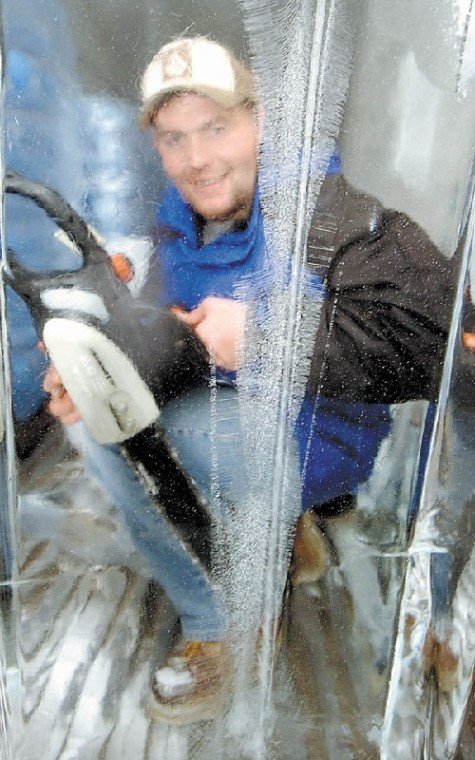By Amanda J.S. Kaufmann
For many residents of Hollister, the Damm name registers its
very own meaning
– that of a family-run water business spanning three
generations. From Damm Soft Water, to Damm Good Water, and most
recently Damm Cold Ice, the Damm family continues to make a name
for itself in the world of water treatment, bottled water and ice
distribution.
By Amanda J.S. Kaufmann
For many residents of Hollister, the Damm name registers its very own meaning – that of a family-run water business spanning three generations. From Damm Soft Water, to Damm Good Water, and most recently Damm Cold Ice, the Damm family continues to make a name for itself in the world of water treatment, bottled water and ice distribution.
Adding another dimension to his background in the family business, Adam Damm, 26, is making a name for himself in the specialized niche, the I’ve-heard-of-that-but-don’t-really-know-anything-about-it world of ice sculpting.
It’s a natural progression for Damm, who runs Damm Good Water, as he was a competitive welder in high school and has spent years building houses with his family.
“When we started Damm Cold Ice, I thought I should know what we were selling, so I asked my brother (who runs Damm Cold Ice). He mentioned 300-pound ice-carving blocks,” Damm says. This was around 2001.
That got his attention.
“I got on the computer and found the National Ice Carving Association – I know, I was laughing, I couldn’t believe it. I called them up and asked, ‘How can I learn to do this?'”
Although the association holds educational seminars, Damm was interested in a different approach. Through more research, he located an ice sculptor in Walnut Creek and called him up.
“That’s the way I am,” he says. “When something interests me, I find out about it, talk to people who are doing it, and ask if I can learn from them.”
After acquiring the techniques, he ordered some blocks of ice from his brother. His first sculpture? A swan.
“I think I broke the neck about 10 times,” he says.
One thing to keep in mind about ice sculpting is that you need the right environment in which to do it – namely a cold one.
Fortunately, because the family business includes an icehouse, Damm was able to find some space for sculpting and storage.
But, to get the kind of permanent space to store tools and the like, he has invested in his own freezer, which measures 10 feet by 12 feet. “It’s the perfect size for me to work in,” he says.
Tools of the trade include a chainsaw, chisels and sometimes a heat torch.
There are some special chisels for ice carving, but mostly it employs standard equipment. And then, of course, you need ice. Will just any old ice do?
“Actually, there are two different kinds of ice,” Damm explains. “One kind is just frozen in the freezer, and air gets trapped. The other is frozen from all sides but the top, and there’s a pump at the top that removes air as the ice freezes.”
Naturally, clear ice is the choice for carving. Damm also notes that you can freeze items in the ice, such as roses, in a series of layers.
This requires special care, as it makes a difference where items are placed in the ice when it comes time to carve.
Ice for carving is generally about 1 foot by 2 feet by 3 feet in size.
For large sculptures, you can freeze blocks together (this is also a handy technique when the sculptor has broken the swan’s neck).
All of these details, as well as what’s involved with the set up, come into play when Damm is pricing a piece for commission. His first piece was a holiday work of art – an Easter Bunny for Ridgemark Golf and Country Club.
Leigh Dietz, Ridgemark’s food and beverage director, has done business with Damm Good Water for years. The ice sculpting came up in a side conversation, and Dietz thought it would be interesting to try, so the bunny was commissioned for an Easter brunch buffet table.
“People were surprised that it was ice,” she says. “The kids loved it.”
Damm typically works in the $200 to $300 range, with most sculptures taking three to four hours to complete – hours are spent standing in a freezer.
“I try not to take breaks, except to step back and look at the sculpture,” he says. “It’s hard to leave the icehouse when you’re in the middle of a carving.
For one thing, the temperature change is too much, and you get sick. The other thing is, you’re covered in snow (from using the chainsaw), which melts and leaves your clothes all wet.”
Nonetheless, inspiration is not a problem, especially when working for hire.
“Mostly, clients say what they want,” Damm says. “I talk to them to get a better understanding of the exact details. A caterer might order a clamshell, but there are a lot of different ways to do clamshells. When I start carving, I’ll make adjustments to fit how things are coming out.”
This organic nature of ice sculpting also affects the initial work in the icehouse, as it’s necessary to keep in mind how much melting will take place once the sculpture is on display. This is especially important when the temperatures are heating up outside.
“I learned to keep things sharp because an hour after you set it up, which is when people just start seeing it, it starts changing,” he says.
Even so, an ice sculpture generally lasts for several hours. Dietz confirms this, saying her Easter Bunny lasted well past the brunch.
Damm also experiments with different lighting to bring his works to life. He recently stumbled upon the effect a black light has – turning the sculpture neon blue.
All in all, Damm has found another outlet for his creative side, one that doesn’t leave him cold.
As he says, “I tried it and liked it. It’s something I can put myself into.”
To commission a piece, contact Damm at (831) 801-5826.














